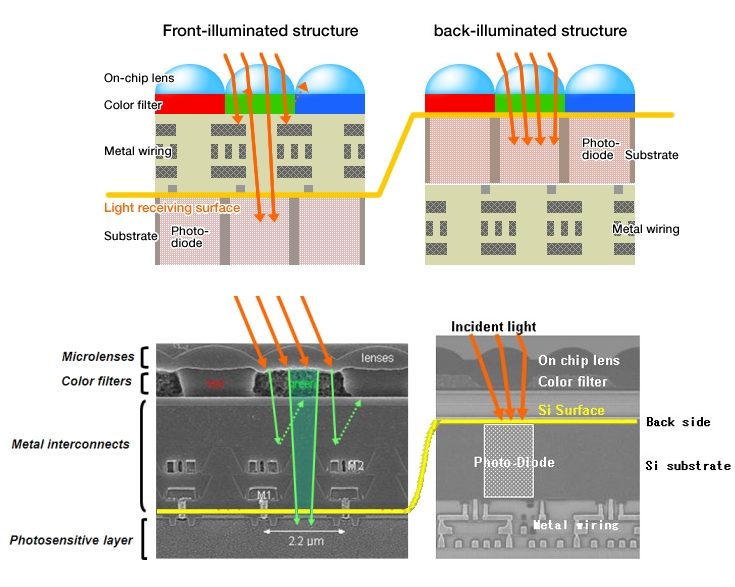it appears those that know more than I do don't believe BSI wouldn't help much with tech lenses and lens cast, but what about cross talk? LCC's perform pretty well with lens cast, not as effective trying to resolve cross talk problems. Is there still a "well" with sides so light can leak through to neighboring pixels?
It's not a well in the same sense, but there's quite a buildup of the color filter and micro lens. See this image:

the slanted light rays shown in the image are at a much higher angle (closer to perpendicular) than a tech lens presents at the edges. I don't have the exact numbers, but I think it can be as low as 30 degrees.
If light comes in at such a low angle there can be crosstalk already in the microlens/color filter layer. The solution to the problem is to make the pixels larger (so the color filter/microlens becomes relatively thinner)
and reduce the aperture of the photo diode (=add light shields), think of laying a thin opaque layer on top of the pixels (but below the color filter) and making a small hole for each pixel. Kodak did that, and removed the microlens completely (which has the problem that it may do more harm than good at low angles). This does not come without cost though.
Smaller aperture of the pixel reduces quantum efficiency, it's basically the same thing as taking a 135 format sensor and spreading out the pixels and not register the light in-between, and as there's gaps between pixels it produces more aliasing. I don't think people would complain about aliasing, somehow medium format users never do, but the reduced quantum efficiency would show up as reduced dynamic range (and worse ISO performance), and that people would notice in their crazy shadow push tests.
With BSI technology the disadvantages could be made much smaller than it was for the Kodak sensors though, so it would still perform very well. I don't think it's necessary to remove the micro lenses for example, but you would probably make a less aggressive design, and the light shield could be narrower thanks to BSI.
Sony won't design a sensor for legacy lenses though. In theory new mirrorless systems would gain from using symmetrical wides as they can be light and compact and at the same time very high performance (and color cast could be corrected in firmware in those systems), but the problem is that these lenses also by necessity have huge vignetting and small aperture, which is okay for technical type of photography, but not for the all-around photography consumers would expect to get from a modern camera.
Angular response is not something that just happens to become what it becomes, it's designed to meet a specific target. To meet that target you need to compromise other performance aspects. When BSI allows you to get more angular response "for free", the likely approach is to increase other aspects of sensor performance, rather than increasing angular response,
unless there is a strong demand to do so. Tech cam lens manufactures are however far better at discontinuing stuff than putting pressure on sensor manufacturers, so I don't think it looks very good.